
Two Seattle area garden designers discovered they have a shared passion for leaves. The result of this synergy is “Fine Foliage,” a rare garden design book in which almost no flowers are allowed. Karen Chapman and Christina Salwitz fill their book with a gallery of plant combinations highlighting leaf color, patterns, size, and shapes in both intimate and large-scale settings.
For each example there is a memorable name (like “Down the Rabbit Hole” or “Deer Be Damned!”), a summary of combined cultural needs, and a “Meet the Players” highlight of the selected plants. Most useful is the “Why This Works” paragraph that highlights the design principles behind each combination and stressing the importance of foliage first in any planting plan. Readers of “The Bulletin” will be interested to see that three of the designs for shady locations were created by Rizaniño “Riz” Reyes, a gardener on the University of Washington Botanic Gardens staff.
Excerpted from the Summer 2013 Arboretum Bulletin.
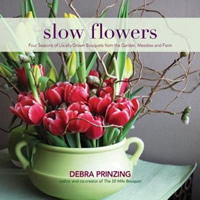 “Slow Flowers” is something of a sequel to “The 50 Mile Bouquet,” Debra Prinzing’s previous book (co-created with photographer David Perry) about local and sustainable cut flower vendors. In this book, she uses the produce (flowers, leaves, seedpods, cones, and other plant material) from those vendors, plus cuttings from her own yard and those of friends to create a calendar full of arrangements, one for each week of the year.
“Slow Flowers” is something of a sequel to “The 50 Mile Bouquet,” Debra Prinzing’s previous book (co-created with photographer David Perry) about local and sustainable cut flower vendors. In this book, she uses the produce (flowers, leaves, seedpods, cones, and other plant material) from those vendors, plus cuttings from her own yard and those of friends to create a calendar full of arrangements, one for each week of the year.
The process for creating each week’s offering is carefully recorded, both in narrative and with an ingredient list complete with sources and a count of each stem. I found the detailed descriptions of the vases, some quite historical, particularly interesting. Tips on design, finding materials, assembling your bouquet–without the use of environmentally unfriendly florist foam–and preserving it when done are sprinkled throughout the book, and in a helpful reference section at the end.
What I like best about this book is the author’s teacher-like approach to everything. No detail is missed, but each is gently mixed with encouragement, practicality, and a sense of fun that makes you want to participate, too.
Excerpted from the Summer 2013 Arboretum Bulletin.
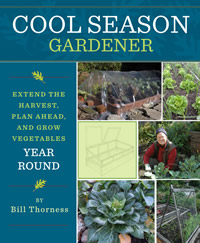
Most vegetable gardening books have a long, encyclopedic listing of favorite crops with a relatively short introduction to general cultural. In “Cool Season Gardener,” Bill Thorness takes a very different approach–the A-Z listing is confined to a short chapter near the end of the book. While these few pages do contain some excellent recommendations for the late summer-to-spring garden, the heart of this book focuses on the practices of vegetable growing, especially for the cooler months.
To do this, the author invites you to change some of your basic concepts, including dividing the year into only four seasons. “Wanting to tend my garden continually throughout the year in our mild climate has made me chop up our seasons into a few ‘miniseasons’ so I can more easily plan and plant.” Spring stretches into three parts from mid-February to mid-July. Summer is a short two-month season. Fall, in two parts (early and late), extends until Thanksgiving, while winter fills the dark months until early spring.
This is an interesting way to revamp the calendar, but more importantly it gives structure to the planting and harvesting schedule. Sadly, it also emphasizes that short summers are a fact of maritime Pacific Northwest life. But don’t despair; the goal of this book is to help you make a success of those long, cool seasons.
Much of this is accomplished with techniques. One whole chapter discusses simple steps for extending the growing season. The next chapter (the longest in the book) covers advanced practices–to a depth of detail not found in other veggie books. Once you’ve absorbed the theory, the appendix gives you the specifics for numerous building projects. This makes it the perfect book for a handy-with-construction gardener–or perhaps the partnership of a handyperson and a gardener.
Unlike some do-it-yourself books, Thorness keeps everything upbeat and sprinkled with practicality and humor–and always with options depending on your skills and resources. “My brain agitates crazily like an old washing machine when I walk through the secondhand stores. Sometimes I take home a box of treasures; other times I leave with just ideas.” You will leave with a treasure of ideas from this book.
Excerpted from the Summer 2013 Arboretum Bulletin.
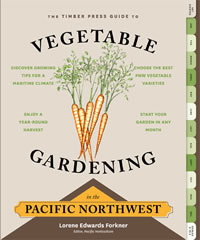 In “The Timber Press Guide to Vegetable Gardening in the Pacific Northwest,” Lorene Edwards Forkner gives a whole calendar of ideas of what to plant and what to harvest every month–what’s unusual is that the chapter on January, while having fewer pages, is still on equal footing with June, rather than be relegated to an off-season category.
In “The Timber Press Guide to Vegetable Gardening in the Pacific Northwest,” Lorene Edwards Forkner gives a whole calendar of ideas of what to plant and what to harvest every month–what’s unusual is that the chapter on January, while having fewer pages, is still on equal footing with June, rather than be relegated to an off-season category.
Does year-round engagement with your garden sound daunting? Relax. Further reading encourages a steady but gentle approach–no more herculean “putting in the garden” effort in the spring–instead be strategic and realistic about how much garden you can handle and thankful for the bountiful resources of our region to provide what you leave out.
While this book is packed with information, it will work well for the novice, as Forkner is good with pointers for getting started. “If you are a beginning gardener, I recommend you learn to love your hose. Time spent at the end of it is the best education and the most accurate barometer of your garden’s needs.” I totally agree.
She also has some interesting ideas for the experienced gardener. She divides her veggies by flavor profiles, and then considers what fits into, for example, “sweet leaves” or “hearty greens.” Within each category there are plant options that which will give you a similar taste result, but some are easier to grow, or provide a harvest at different times of the year. This can simplify the planting list enormously.
Excerpted from the Summer 2013 Arboretum Bulletin.
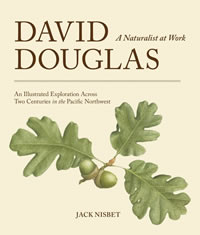 Jack Nisbet’s first book about David Douglas (“The Collector” from 2009) was a very popular, journal-like life chronology of the intrepid plant explorer. The enthusiastic response led the author to realize “…I had only begun to touch the dynamic worlds he [Douglas] saw. So I went back on the trail, revisiting places he had described, checking on species of flora and fauna he had collected, following any lead that might reveal additional facets of his career and character.”
Jack Nisbet’s first book about David Douglas (“The Collector” from 2009) was a very popular, journal-like life chronology of the intrepid plant explorer. The enthusiastic response led the author to realize “…I had only begun to touch the dynamic worlds he [Douglas] saw. So I went back on the trail, revisiting places he had described, checking on species of flora and fauna he had collected, following any lead that might reveal additional facets of his career and character.”
The result is a new book, “David Douglas: A Naturalist at Work.” Instead of a year-by-year account, this is a delightful collection of essays that explores themes as they played out over Douglas’s entire, all-too-short career. Several chapters explore the different groups of people he worked or lived amongst including Native Americans, fur traders, sea farers, and members of the scientific community in England and North America. He did his best to fit in with all and this may explain much of his success as a collector–his eager personality encouraged others to share their knowledge or provide help with explorations.
This new book also incorporates observations from current day researchers that are influenced by Douglas almost two centuries later. For example, he was very enamored with the Garry Oak (Quercus garryana) and the communities it formed in the Pacific Northwest. Present day biologist Peter Dunwiddie has tried to understand why these communities are so rare today. While Dunwiddie concludes there are several factors, the most important is “…the way Native Americans throughout the region systematically set fire to these open oak woodlands,” a practice that did not continue after the early 19th century.
Excerpted from the Summer 2013 Arboretum Bulletin.
 The Orchard Mason Bee by Bellingham author Brian Griffin has long been my go-to book on this subject, but from just across the border in Coquitlam, B.C., is a slightly newer book (2002) on these fascinating garden helpers. “Pollination with Mason Bees” by Margriet Dogterom, takes a bit more of a do-it-yourself approach to creating and maintaining your bee nests, but if you’re interested in this subject, I’d recommend referring to both books.
The Orchard Mason Bee by Bellingham author Brian Griffin has long been my go-to book on this subject, but from just across the border in Coquitlam, B.C., is a slightly newer book (2002) on these fascinating garden helpers. “Pollination with Mason Bees” by Margriet Dogterom, takes a bit more of a do-it-yourself approach to creating and maintaining your bee nests, but if you’re interested in this subject, I’d recommend referring to both books.
Excerpted from the Summer 2013 Arboretum Bulletin.
“It’s a Jungle Out There!” is a collection of essays by Cass Turnbull from the time of the founding of Plant Amnesty. It give some perspective and appreciation for the success of her efforts in educating the public and professionals on proper tree and shrub care. While not available to borrow, this book is worth looking at for its history and, especially, the charming diagrams.
Excerpted from the Spring 2013 Arboretum Bulletin.
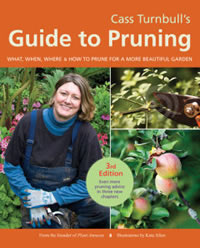 Cass Turnbull needs no introduction to our readers and a new book by her is a cause for celebration. Her “Guide to Pruning” is now available in its 3rd edition with three added chapters, including a much needed essay on Taming the Native-Plant Garden. She also addressed an impressive list of new plants not considered in the earlier editions, including “whackables” such as Lavatera and Perovskia. Oh, how I wish I had read about the dangers of whacking too soon–before making my mid-February cutbacks in my own garden.
Cass Turnbull needs no introduction to our readers and a new book by her is a cause for celebration. Her “Guide to Pruning” is now available in its 3rd edition with three added chapters, including a much needed essay on Taming the Native-Plant Garden. She also addressed an impressive list of new plants not considered in the earlier editions, including “whackables” such as Lavatera and Perovskia. Oh, how I wish I had read about the dangers of whacking too soon–before making my mid-February cutbacks in my own garden.
Excerpted from the Spring 2013 Arboretum Bulletin.
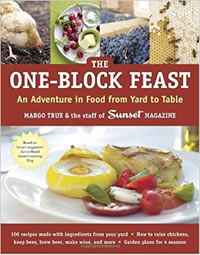 From a publisher a bit out of the region but very familiar to us all is The One-Block Feast by Margo True and the staff of Sunset Magazine. Essentially this is a scrapbook of the an on-going experiment to grow, harvest, prepare, and cook a full menu, all from very local sources–the Menlo Park, California campus of this long-time fount of wisdom for gardeners throughout the west.
From a publisher a bit out of the region but very familiar to us all is The One-Block Feast by Margo True and the staff of Sunset Magazine. Essentially this is a scrapbook of the an on-going experiment to grow, harvest, prepare, and cook a full menu, all from very local sources–the Menlo Park, California campus of this long-time fount of wisdom for gardeners throughout the west.
While one must make modifications for the Pacific Northwest (a calendar of regionally adjusted planting and harvesting dates in the appendix will help), you can’t help but come away from reading this book full of ideas. The staff formed teams by food type, and weren’t afraid to tackle almost anything from honey to cheese, or beer to olive oil. I thought the stories of Team Salt and Team Escargot were the most intriguing.
Excerpted from the Spring 2013 Arboretum Bulletin.
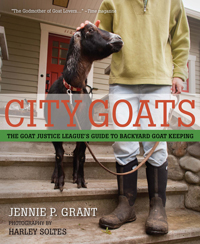 Jennie P. Grant brings a full measure of enthusiasm to “City Goats,” a combination how-to manual, goat keeping manifesto, and love story, made all the better by its Seattle setting. While much of the care-giving information would apply to goats anywhere, the author’s campaign to legalize her herd is especially compelling because of its local connections.
Jennie P. Grant brings a full measure of enthusiasm to “City Goats,” a combination how-to manual, goat keeping manifesto, and love story, made all the better by its Seattle setting. While much of the care-giving information would apply to goats anywhere, the author’s campaign to legalize her herd is especially compelling because of its local connections.
I’m not likely to start my own herd, but I couldn’t help getting hooked by the exploits and personalities of Brownie, Snowflake, Maple, and Eloise. Is this a gardening book? Perhaps not, as the author makes it very clear that your goats and your roses are not good companions. However as the model of the urban farm continues to flourish, you may embrace having your own source of milk and veggies, from securely separated sites, of course.
Excerpted from the Spring 2013 Arboretum Bulletin.

 “Slow Flowers” is something of a sequel to “The 50 Mile Bouquet,” Debra Prinzing’s previous book (co-created with photographer David Perry) about local and sustainable cut flower vendors. In this book, she uses the produce (flowers, leaves, seedpods, cones, and other plant material) from those vendors, plus cuttings from her own yard and those of friends to create a calendar full of arrangements, one for each week of the year.
“Slow Flowers” is something of a sequel to “The 50 Mile Bouquet,” Debra Prinzing’s previous book (co-created with photographer David Perry) about local and sustainable cut flower vendors. In this book, she uses the produce (flowers, leaves, seedpods, cones, and other plant material) from those vendors, plus cuttings from her own yard and those of friends to create a calendar full of arrangements, one for each week of the year.
 In “The Timber Press Guide to Vegetable Gardening in the Pacific Northwest,” Lorene Edwards Forkner gives a whole calendar of ideas of what to plant and what to harvest every month–what’s unusual is that the chapter on January, while having fewer pages, is still on equal footing with June, rather than be relegated to an off-season category.
In “The Timber Press Guide to Vegetable Gardening in the Pacific Northwest,” Lorene Edwards Forkner gives a whole calendar of ideas of what to plant and what to harvest every month–what’s unusual is that the chapter on January, while having fewer pages, is still on equal footing with June, rather than be relegated to an off-season category. Jack Nisbet’s first book about David Douglas (“The Collector” from 2009) was a very popular, journal-like life chronology of the intrepid plant explorer. The enthusiastic response led the author to realize “…I had only begun to touch the dynamic worlds he [Douglas] saw. So I went back on the trail, revisiting places he had described, checking on species of flora and fauna he had collected, following any lead that might reveal additional facets of his career and character.”
Jack Nisbet’s first book about David Douglas (“The Collector” from 2009) was a very popular, journal-like life chronology of the intrepid plant explorer. The enthusiastic response led the author to realize “…I had only begun to touch the dynamic worlds he [Douglas] saw. So I went back on the trail, revisiting places he had described, checking on species of flora and fauna he had collected, following any lead that might reveal additional facets of his career and character.” The Orchard Mason Bee by Bellingham author Brian Griffin has long been my go-to book on this subject, but from just across the border in Coquitlam, B.C., is a slightly newer book (2002) on these fascinating garden helpers.
The Orchard Mason Bee by Bellingham author Brian Griffin has long been my go-to book on this subject, but from just across the border in Coquitlam, B.C., is a slightly newer book (2002) on these fascinating garden helpers.  Cass Turnbull needs no introduction to our readers and a new book by her is a cause for celebration. Her “Guide to Pruning” is now available in its 3rd edition with three added chapters, including a much needed essay on Taming the Native-Plant Garden. She also addressed an impressive list of new plants not considered in the earlier editions, including “whackables” such as Lavatera and Perovskia. Oh, how I wish I had read about the dangers of whacking too soon–before making my mid-February cutbacks in my own garden.
Cass Turnbull needs no introduction to our readers and a new book by her is a cause for celebration. Her “Guide to Pruning” is now available in its 3rd edition with three added chapters, including a much needed essay on Taming the Native-Plant Garden. She also addressed an impressive list of new plants not considered in the earlier editions, including “whackables” such as Lavatera and Perovskia. Oh, how I wish I had read about the dangers of whacking too soon–before making my mid-February cutbacks in my own garden. From a publisher a bit out of the region but very familiar to us all is The One-Block Feast by Margo True and the staff of Sunset Magazine. Essentially this is a scrapbook of the an on-going experiment to grow, harvest, prepare, and cook a full menu, all from very local sources–the Menlo Park, California campus of this long-time fount of wisdom for gardeners throughout the west.
From a publisher a bit out of the region but very familiar to us all is The One-Block Feast by Margo True and the staff of Sunset Magazine. Essentially this is a scrapbook of the an on-going experiment to grow, harvest, prepare, and cook a full menu, all from very local sources–the Menlo Park, California campus of this long-time fount of wisdom for gardeners throughout the west. Jennie P. Grant brings a full measure of enthusiasm to “City Goats,” a combination how-to manual, goat keeping manifesto, and love story, made all the better by its Seattle setting. While much of the care-giving information would apply to goats anywhere, the author’s campaign to legalize her herd is especially compelling because of its local connections.
Jennie P. Grant brings a full measure of enthusiasm to “City Goats,” a combination how-to manual, goat keeping manifesto, and love story, made all the better by its Seattle setting. While much of the care-giving information would apply to goats anywhere, the author’s campaign to legalize her herd is especially compelling because of its local connections.